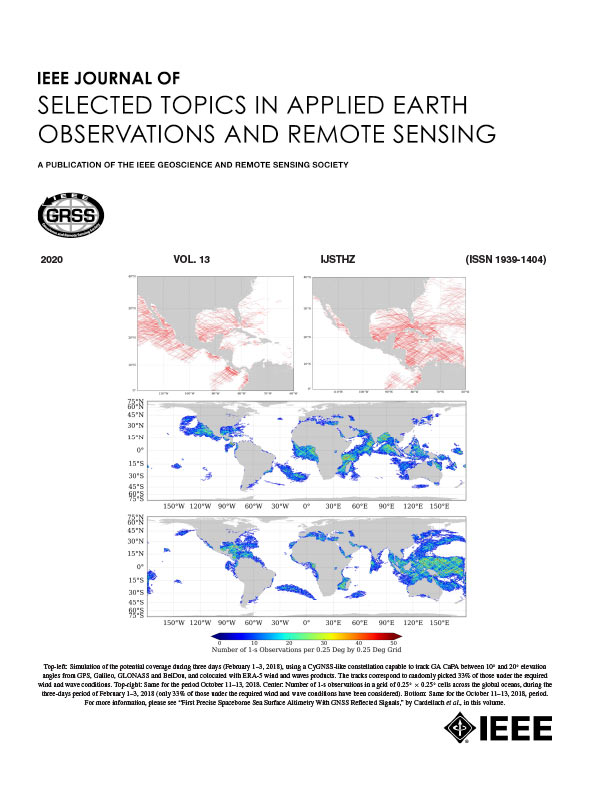电离层法拉第旋转影响下低频星载全极化SAR数据的改进处理方法
IF 4.7
2区 地球科学
Q1 ENGINEERING, ELECTRICAL & ELECTRONIC
IEEE Journal of Selected Topics in Applied Earth Observations and Remote Sensing
Pub Date : 2025-06-19
DOI:10.1109/JSTARS.2025.3581144
引用次数: 0
摘要
星载全极化(FP)合成孔径雷达(SAR)系统是一种低频(如L波段或p波段)工作的强大微波传感器,用于捕获地球表面信息。然而,这种传感器获取的数据的应用有效性取决于对电离层法拉第旋转(FR)影响的处理和可能存在的某些系统误差。本文提出了一种改进的处理低频星载FP SAR数据的方法,该方法在存在加性噪声的情况下产生用于偏振分析的3 × 3相干矩阵(CM)。该方法的关键是通过直接将测量的4 × 4 CM与估计的FR进行校正而得到的FR校正后的4 × 4 CM的改进二分法。该二分法是在两个具有明确物理意义的约束条件下,基于4 × 4矩阵的Schur补求解FR校正后的4 × 4 CM的最优二分法得到的。具体地说,分解后的两个分量是厄米分量和正半定分量,而与加性噪声相关的分量具有最小的迹线。从极化散射熵和第二分量迹线的角度出发,通过与基本步骤相同但采用常用直接二分法的处理方法进行比较,在不同的l波段ALOS PALSAR和ALOS-2 PALSAR-2 FP采集数据上验证了改进的二分法处理方法的有效性和鲁棒性。实验结果表明,改进后的处理方法可以有效地减轻加性噪声对生成的3 × 3 CM的影响。本文章由计算机程序翻译,如有差异,请以英文原文为准。
An Improved Processing Method for Low-Frequency Spaceborne Full-Polarimetric SAR Data Affected by Ionospheric Faraday Rotation
Spaceborne full-polarimetric (FP) synthetic aperture radar (SAR) system operating at low frequency (such as L- or P-band) is a powerful microwave sensor used to capture the Earth’s surface information. However, the application effectiveness of the data acquired by such a sensor depends on the processing for the effects of ionospheric Faraday rotation (FR) and possibly-existing certain system errors. This article develops an improved processing method for low-frequency spaceborne FP SAR data affected by FR in the presence of additive noise to generate the 3 × 3 coherency matrix (CM) used for polarimetric analysis. The key to this method is an improved dichotomy of the FR corrected 4 × 4 CM obtained by directly correcting the measured 4 × 4 CM with the estimated FR. The dichotomy is obtained by solving an optimal dichotomy of the FR corrected 4 × 4 CM based on the Schur complement of a 4 × 4 matrix under two constraints with clear physical significance. Specifically, the two decomposed components are Hermitian and positive semidefinite, while the component related to additive noise possesses the smallest trace. From the perspective of polarimetric scattering entropy and the trace of the second component, the effectiveness and robustness of the improved processing method featuring the proposed dichotomy is tested on diverse L-band ALOS PALSAR and ALOS-2 PALSAR-2 FP acquisitions by comparing it with the processing method holding the same basic steps but applying the commonly used direct dichotomy. Experimental results indicate that the improved processing method can effectively alleviate the influence of additive noise on the generated 3 × 3 CM.
求助全文
通过发布文献求助,成功后即可免费获取论文全文。
去求助
来源期刊
CiteScore
9.30
自引率
10.90%
发文量
563
审稿时长
4.7 months
期刊介绍:
The IEEE Journal of Selected Topics in Applied Earth Observations and Remote Sensing addresses the growing field of applications in Earth observations and remote sensing, and also provides a venue for the rapidly expanding special issues that are being sponsored by the IEEE Geosciences and Remote Sensing Society. The journal draws upon the experience of the highly successful “IEEE Transactions on Geoscience and Remote Sensing” and provide a complementary medium for the wide range of topics in applied earth observations. The ‘Applications’ areas encompasses the societal benefit areas of the Global Earth Observations Systems of Systems (GEOSS) program. Through deliberations over two years, ministers from 50 countries agreed to identify nine areas where Earth observation could positively impact the quality of life and health of their respective countries. Some of these are areas not traditionally addressed in the IEEE context. These include biodiversity, health and climate. Yet it is the skill sets of IEEE members, in areas such as observations, communications, computers, signal processing, standards and ocean engineering, that form the technical underpinnings of GEOSS. Thus, the Journal attracts a broad range of interests that serves both present members in new ways and expands the IEEE visibility into new areas.

 求助内容:
求助内容: 应助结果提醒方式:
应助结果提醒方式:


